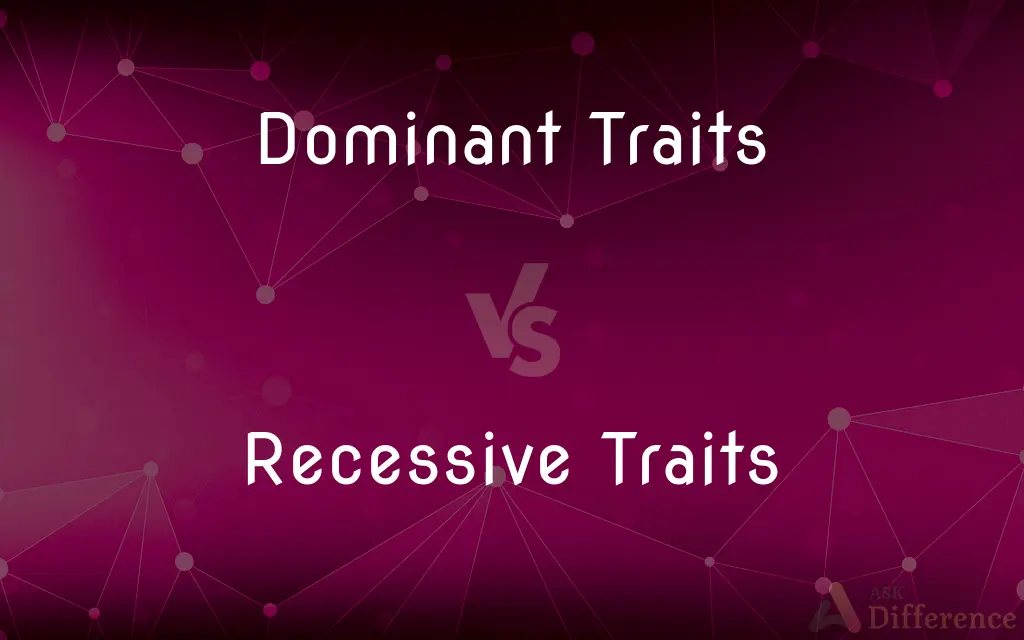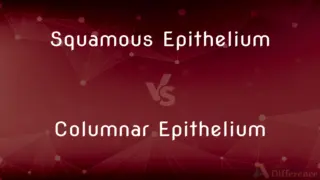Dominant Traits vs. Recessive Traits — What's the Difference?
By Tayyaba Rehman — Published on January 13, 2024
Dominant traits are expressed in offspring even if only one parent passes them, while recessive traits require both parents to pass them for expression.

Difference Between Dominant Traits and Recessive Traits
Table of Contents
ADVERTISEMENT
Key Differences
Dominant Traits are those that are expressed in an organism even if only one copy of the gene is present. They mask the effect of recessive traits when paired together. In contrast, Recessive Traits only appear when two copies of the gene, one from each parent, are present. If paired with a dominant trait, the recessive trait is not expressed.
Dominant Traits are often observed more frequently in populations because it takes only one dominant allele to express the trait. For example, brown eyes are a dominant trait in humans. On the other hand, Recessive Traits, such as blue eyes, are less commonly expressed because they require two copies of the recessive allele.
When considering genetics, an individual carrying a Dominant Trait may be homozygous (having two identical alleles) or heterozygous (having one dominant and one recessive allele). However, for a Recessive Trait to be expressed, the individual must be homozygous recessive, as the presence of a dominant allele would mask the recessive trait.
In breeding and genetic studies, Dominant Traits tend to mask the presence of other alleles, making it difficult to determine an organism's genotype just by its phenotype. In contrast, Recessive Traits when expressed, confirm the organism’s homozygous recessive genotype.
Examples of Dominant Traits in humans include having freckles or curly hair, while examples of Recessive Traits include having red hair or being affected by certain genetic disorders like cystic fibrosis, which require two copies of the recessive allele to be expressed.
ADVERTISEMENT
Comparison Chart
Expression
Expressed with one copy
Require two copies to be expressed
Masking Ability
Masks recessive traits
Masked by dominant traits
Frequency in Populations
Often more common
Less common
Genetic Representation
Can be homozygous or heterozygous
Only expressed in homozygous recessive
Examples
Brown eyes, freckles
Blue eyes, red hair
Compare with Definitions
Dominant Traits
Expressed with a single copy of the gene.
Having brown eyes is a dominant trait in humans.
Recessive Traits
Require two copies for expression.
Blue eyes are a recessive trait requiring two recessive alleles.
Dominant Traits
Often more prevalent in populations.
Dominant traits like curly hair are more commonly observed.
Recessive Traits
Not expressed in the presence of a dominant trait.
Recessive traits like red hair are masked by more dominant hair colors.
Dominant Traits
Dominant traits are easier to identify.
Dominant traits like attached earlobes are easily noticeable.
Recessive Traits
Often masked in heterozygous pairings.
In a heterozygous pairing, the recessive trait for blonde hair is masked.
Dominant Traits
Masks the effect of a recessive trait.
The dominant gene for dark hair color masks the recessive gene for blonde hair.
Recessive Traits
Less common in populations.
Recessive traits, such as albinism, are rare in the population.
Dominant Traits
Can be homozygous or heterozygous.
A person with one dominant allele for freckles will still show the trait.
Recessive Traits
Only expressed in homozygous recessive individuals.
Cystic fibrosis is expressed only in individuals with two recessive alleles.
Common Curiosities
Can a child have a recessive trait if one parent has a dominant trait?
Yes, if the other parent provides the recessive allele and the dominant parent is heterozygous.
Are dominant traits more common than recessive traits?
In general, yes, as they require only one copy to be expressed.
Can two parents with a recessive trait have a child with a dominant trait?
No, if both parents only carry recessive alleles.
What determines if a trait is dominant or recessive?
The underlying genetic mechanism and how alleles interact determine dominance and recessiveness.
Do dominant traits skip generations?
Less likely, as they tend to be expressed whenever the allele is present.
Why are some dominant traits not always harmful?
Dominant traits are not inherently harmful or beneficial; it depends on the specific trait.
What is a recessive trait?
A trait that is only expressed when two recessive alleles are present.
Are all genetic diseases caused by recessive traits?
Not all; some genetic diseases are caused by dominant or even mutations in a single gene.
Why are recessive genetic disorders less common?
Because they require both parents to pass on the recessive allele.
What is a dominant trait?
A trait that is expressed even if only one dominant allele is present.
Can two people with dominant traits have a child with recessive traits?
Yes, if both parents are heterozygous, carrying both dominant and recessive alleles.
Is eye color a result of dominant and recessive traits?
Yes, eye color is influenced by both types of traits.
Can an individual carry a recessive trait without expressing it?
Yes, as a carrier, they can have one recessive and one dominant allele.
How are recessive traits inherited?
Through the passing of recessive alleles from both parents.
Can the environment affect the expression of dominant or recessive traits?
While traits are genetically determined, environmental factors can sometimes influence their expression.
Share Your Discovery

Previous Comparison
Squamous Epithelium vs. Columnar Epithelium
Next Comparison
Character Array vs. StringAuthor Spotlight
Written by
Tayyaba RehmanTayyaba Rehman is a distinguished writer, currently serving as a primary contributor to askdifference.com. As a researcher in semantics and etymology, Tayyaba's passion for the complexity of languages and their distinctions has found a perfect home on the platform. Tayyaba delves into the intricacies of language, distinguishing between commonly confused words and phrases, thereby providing clarity for readers worldwide.
















































